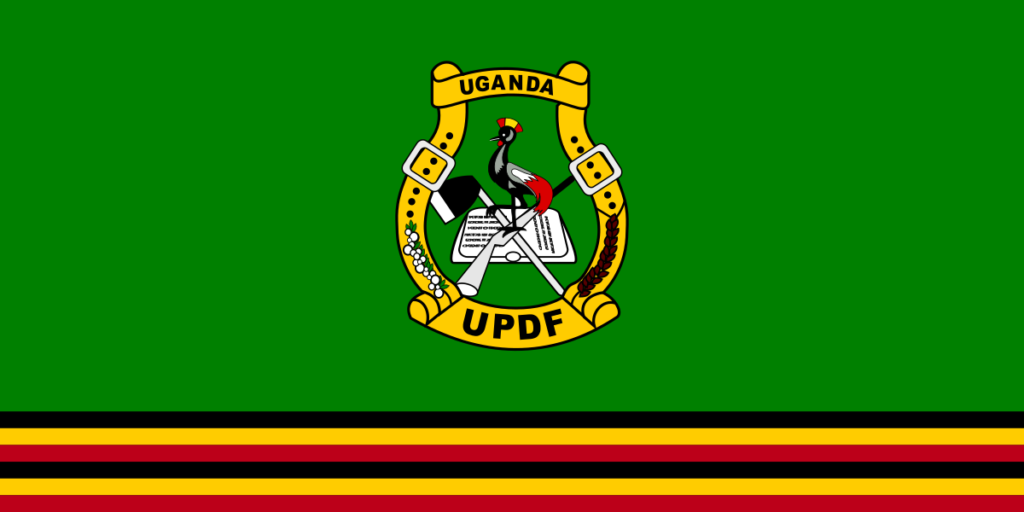The Republic of Uganda is an East African state with an area of 236 thousand square kilometers and a population of 44.8 million people.
This is what the modern flag of Uganda looks like:

History of the flag
The kingdom of Buganda existed on the territory of modern Uganda, whose rulers played a significant role in the central part of the African continent from the 18th to the 20th century. The banner of the kingdom was a banner of blue and white vertical stripes with a shield and a lion’s coat of arms in the center.

In addition to the kingdom of Buganda, there are currently four other kingdoms on the territory of Uganda. All of them have the rights of cultural autonomies. Each also has its own flag.
By the end of the 19th century the territory came under British protectorate. During this period the first letter disappeared from the name and the former name became «Uganda». The symbol of the territory during the British rule was a cloth with the official symbol of the empire.

Flag of Uganda 1894 — 1914:

As for other colonial British possessions, a new symbolism was developed for the Uganda Protectorate in 1914.

At the same time, the British Territory governor’s standard applied.

These symbols, indicating Uganda’s affiliation, lasted until 1962, when the country was granted independence.
In March 1962, Uganda was granted self-government. Between March and October, when independence was granted, the national symbol of the country was of a different kind.

In October 1962, the national flag of Uganda was adopted.
Description
The national symbol of the country has six equal horizontal stripes, depicted twice in the following sequence: black, yellow, red. In the central part of the flag on a white disc is the national symbol — a crowned crane, which looks towards the flag’s staff. In addition to the aforementioned color scheme, a gray color is used to represent it.
The cloth has a rectangular shape with an aspect ratio of 2 to 3.
Flag colors
The flag of the Republic has five colors: black, yellow, red, white, and gray.
Meaning of colors and flag symbol
The three colors used on the symbol of the country are characteristic of Africa and symbolize:
- black — residents;
- yellow is the sun of Africa;
- red — blood, uniting people, as well as African brotherhood.
Balearica regulorum (Eastern crowned crane), depicted in a white circle is the national symbol of Uganda. The raised leg of the bird signifies the forward movement of the country.
Other Flags
Relatively young, by historical standards, the Republic, in addition to the state symbol, has other symbols. Their distinctive feature is that the lower part shows the appearance of the main symbol — black-yellow-red stripes, and already in its upper part the attribution to a particular state structure. Examples of flags are presented for illustrative purposes:
- Presidential;

- Self-Defense Forces of the People’s Republic;

- Air Force of the Republic of Uganda

General information about Uganda
| Official language | English and Kiswahili |
| Capital | Kampala |
| Territory | 236,040 km² |
| Population | 44,758,809 people |
| Currency | Ugandan shilling |
| Phone Code | +256 |










Как мужчина по имени Роман, хочу отметить, что флаг Уганды действительно уникален. Его яркие полосы черного, желтого и красного цветов символизируют богатое историческое наследие и разнообразие культуры страны. Особенно впечатляет образ журавля, который олицетворяет мир и единство. Угандийцы гордятся своим флагом, и он служит напоминанием о важности национальной идентичности. Интересно было бы узнать больше о том, как элементы флага влияют на восприятие Уганды за пределами страны.
I remember seeing the Flag of Uganda for the first time during a cultural festival. The bold colors really stood out! I loved learning about its meaning and how it represents the country’s rich heritage. It sparked my interest in exploring more about Ugandan traditions. What an inspiring experience!
I remember visiting Uganda and seeing the flag everywhere! It’s so striking with its black, yellow, and red colors. The moment I arrived, I felt the energy of the people and their pride in their country. The flag truly represents the vibrant culture and history.
I once met a traveler from Uganda who shared the significance of their flag’s colors. Each stripe represents something special about their culture and history. It was eye-opening to learn how much pride they take in their identity. Flags can tell powerful stories!